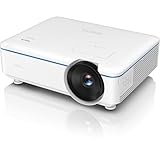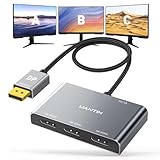Yes, you can daisy chain projectors—but it depends on the type of projector and the video signal you’re using.
Imagine turning a single source into a multi-projector experience without complicated wiring or expensive switchers. That’s the promise of daisy chaining: connecting multiple projectors in a series using a single video source to project the same content across several screens.
This setup is popular in large venues, immersive art installations, multi-screen presentations, and even high-end home theaters. However, it’s not as plug-and-play as many might hope. Not all projectors support daisy chaining natively, and even those that do often require specific ports like HDMI Out or DisplayPort Multi-Stream Transport (MST).
Best for Daisy Chaining Projectors: Top 3 Recommended Products
If you’re planning to daisy chain projectors for presentations, events, or immersive environments, you’ll need equipment that supports signal pass-through or has compatible ports like HDMI Out or DisplayPort. Here are three top-tier projectors that stand out:
Epson PowerLite L735U Laser Projector
Why it’s great:
This Epson model features HDBaseT and HDMI output, making it ideal for daisy chaining in large venues. Its 7,000-lumen brightness ensures vivid images even in well-lit spaces.
- Experience true-to-life colors thanks to the 3LCD, 3-chip technology
- Allows you to enjoy striking display with the 7000 lm brightness
- Enjoy crystal clear projection with WUXGA resolution
BenQ LU950 DLP WUXGA Laser Projector
Why it’s great:
With HDMI loop-through and high-resolution output, this projector supports multiple display connections without lag. Its laser light source ensures longevity and minimal maintenance.
Optoma ZH506T Professional Laser Projector
Why it’s great:
Equipped with vertical lens shift, HDMI out, and robust compatibility, this model is excellent for stacking or chaining in corporate or event settings.
- IP6X-certified Dust Resistance
- 360 Orientation For Installation
- Full HD 3D Support
Other related products to consider:
- HDMI splitter with loop-out (e.g., J-Tech Digital 4K HDMI Splitter)
- ✅ 1 HDMI Input to 2 HDMI Outputs – This affordable 1 x 2 HDMI splitter…
- ✅ Mix Different Display Resolutions – A Multi-Resolution Output (MRO)…
- ✅ HD Audio Formats Supported – Supports all HD audio formats, including…
- 【DisplayPort Splitter 1 in 3 Out】UANTIN DisplayPort Splitter Adapter…
- 【4K UHD Visual Feast】Expand your monitors with this Display Port…
- 【Plug and Play Solution】DisplayPort to Dual DisplayPort splitter is…
- ✓ 𝐄𝐗𝐓𝐄𝐍𝐃 𝐘𝐎𝐔𝐑 𝐇𝐃𝐌𝐈…
- ✓ 𝐆𝐑𝐄𝐀𝐓 𝐂𝐎𝐌𝐏𝐔𝐓𝐄𝐑…
- ✓ 𝐁𝐈-𝐃𝐈𝐑𝐄𝐂𝐓𝐈𝐎𝐍𝐀𝐋 𝐏𝐎𝐂,…
What Does Daisy Chaining a Projector Mean?
Daisy chaining a projector refers to connecting multiple projectors to a single video source in a serial configuration—one projector links to the next, forming a chain. This setup allows the same content to be displayed across several projectors without needing separate signal sources for each one.
Instead of sending individual HDMI or DisplayPort signals to each projector, daisy chaining simplifies the process. You send the video signal to the first projector, which then passes it along to the second, third, and so on—provided the projectors support this functionality.
How It Works:
- Input signal: Your content source (like a laptop or media player) sends a video signal into the first projector.
- Output signal: The first projector has an HDMI Out or DisplayPort Out, which passes the same signal to the next projector.
- Repeating the chain: This process continues depending on how many projectors support output and how strong the signal remains.
Key Features Required:
- HDMI/DisplayPort Out or loop-through ports
- Support for Multi-Stream Transport (for DisplayPort)
- HDBaseT pass-through in professional setups
Benefits:
- Reduced cable clutter
- Single source control
- Ideal for large events, digital signage, and multi-room displays
However, not all projectors support daisy chaining natively. It’s crucial to check if your device has the required output ports. In some cases, you might need external devices like HDMI splitters with signal boosters or AV switchers to replicate this effect.
Which Projectors Support Daisy Chaining?
Not all projectors are built to support daisy chaining. To make this setup work, the projector must have specific output ports—most commonly HDMI Out, DisplayPort Out, or HDBaseT pass-through. These allow the projector to receive a video signal and then pass it along to another display device.
Projectors That Typically Support Daisy Chaining:
Business & Professional Models:
- Epson PowerLite L Series – Features HDBaseT and HDMI output for easy chaining in large venues.
- BenQ LU950 – Includes HDMI loop-through and high brightness for conference rooms.
- Panasonic PT-VMZ Series – WUXGA resolution with signal pass-through for event staging.
Commercial & Event Installers:
- Christie Digital Projectors – Known for supporting advanced daisy chaining in digital signage and theater environments.
- Barco UDX Series – Offers edge blending, 4K capability, and DisplayPort MST for high-end AV workflows.
Some High-End Home Theater Models:
- Very few consumer-grade home theater projectors support native daisy chaining, but some may include HDMI Out for limited uses such as audio pass-through.
Things to Look For:
- HDMI Out or HDMI Loop-Through
- DisplayPort MST (Multi-Stream Transport)
- HDBaseT Input/Output
- Firmware or software support for signal passing
Budget projectors and portable models often lack these features. In those cases, you’ll need an external HDMI splitter, which duplicates the signal but doesn’t technically “daisy chain.” Still, it serves a similar function by allowing multiple projectors to display the same content.
How to Daisy Chain Projectors: Step-by-Step Setup Guide
Daisy chaining projectors can seem intimidating at first, but with the right equipment and method, it’s a straightforward process. Here’s a step-by-step guide to help you set up a daisy-chained projector configuration.
Step 1: Check Your Equipment
Before anything else, ensure all your projectors support daisy chaining. Look for:
- HDMI Out, DisplayPort Out, or HDBaseT ports
- Signal pass-through capabilities in the manual/specs
Step 2: Gather Your Components
You’ll need:
- Compatible projectors
- High-speed HDMI or DisplayPort cables
- Source device (laptop, media server, console, etc.)
- Optional: HDMI splitter (if your projectors lack HDMI Out)
Step 3: Connect the First Projector
- Plug the video source into the HDMI or DisplayPort In on the first projector.
- Set the input source correctly using the projector’s menu settings.
Step 4: Link the Next Projector
- From the HDMI/DP Out of the first projector, connect to the HDMI/DP In on the second projector.
- Repeat this process for additional projectors, if supported.
Step 5: Adjust Settings
- Ensure all projectors are displaying the signal.
- Some models allow you to mirror or extend the display—set them to mirror mode if you want the same image across all units.
Step 6: Test the Setup
Check for image quality, lag, or signal degradation. You may need to use signal boosters if the chain is long.
Pros and Cons of Daisy Chaining Projectors
Daisy chaining projectors can be incredibly useful in certain scenarios, but it’s not without its drawbacks. Let’s break down the key advantages and limitations so you can decide if it’s the right solution for your setup.
Pros of Daisy Chaining Projectors
- Simplified Cable Management
You only need a single source and fewer long cables, reducing clutter. - Cost-Effective for Multi-Display Setups
Eliminates the need for expensive AV switchers or multiple source devices. - Centralized Control
Adjust and manage content from a single device or media player. - Perfect for Large Spaces
Ideal for conferences, digital signage, or immersive visual installations. - Less Hardware Required
No need for external splitters or signal duplicators if projectors support pass-through.
Cons of Daisy Chaining Projectors
- Compatibility Limitations
Most consumer projectors don’t support HDMI/DisplayPort output natively. - Signal Degradation
Video quality may decrease with each additional projector unless signal boosters are used. - Lag or Sync Issues
Chained projectors might display slight delays, especially in real-time video or gaming applications. - Limited Number of Units
There’s often a cap on how many projectors can be chained—usually 2 to 4 max—before quality suffers. - Complex Setup Troubleshooting
Identifying where a signal breaks in the chain can be time-consuming.
Daisy chaining works best when used with professional-grade projectors designed for multi-display environments. For casual users or basic home theater setups, alternatives like HDMI splitters may be more practical.
Alternative Ways to Connect Multiple Projectors
If your projectors don’t support native daisy chaining, don’t worry—you can still connect multiple projectors using alternative methods. These solutions achieve the same goal: displaying content from one source on more than one projector.
HDMI Splitters
An HDMI splitter takes one input signal and duplicates it to multiple HDMI outputs. This is a great workaround if your projectors lack HDMI Out or pass-through features.
Best for:
- Home theaters
- Presentations
- Churches and classrooms
Pro Tip:
Choose a powered splitter with 4K support and HDCP compatibility to prevent signal loss and maintain video quality.
Wireless HDMI Transmitters
Wireless HDMI kits allow you to broadcast the same video signal to multiple projectors without running cables.
Best for:
- Ceiling-mounted projectors
- Temporary event setups
- Spaces with limited wiring options
Downside:
Wireless signals can suffer interference or latency, especially in crowded Wi-Fi environments.
AV Matrix Switchers
These professional-grade devices allow multiple inputs and outputs and offer full control over signal routing.
Best for:
- Digital signage
- Live events
- Large auditoriums
Benefit:
Scalable and reliable for complex AV configurations.
Software-Based Display Control
Software like DisplayFusion, MultiMonitorTool, or Windows Extended Display allows content to be distributed to several projectors through multiple video outputs from a PC.
Best for:
- Advanced multimedia presentations
- Interactive exhibitions
- Multi-display video walls
If daisy chaining isn’t an option, these alternatives provide reliable and flexible ways to share content across multiple screens.
Conclusion
So, can you daisy chain projectors? Yes—but only if your projectors support it. Daisy chaining offers a clean and centralized way to display the same content across multiple screens, especially useful in large venues, presentations, and events.
However, it’s not a universal feature. Only select models—mostly commercial or professional-grade—come equipped with HDMI Out, DisplayPort MST, or HDBaseT for signal pass-through. If your current projectors lack these ports, don’t worry. Alternative methods like HDMI splitters, wireless transmitters, or AV switchers can achieve similar results2. How many projectors can I daisy chain together?
Typically, you can daisy chain up to 3–4 projectors reliably. Beyond that, the signal quality may degrade unless you’re using high-end professional equipment with signal amplification or repeaters. with minimal compromise.
Frequently Asked Questions About Daisy Chaining Projectors
Can I daisy chain any projector?
No. Only projectors with HDMI Out, DisplayPort Out, or HDBaseT pass-through can be daisy chained. Most consumer-grade or budget models do not include these features. Always check the projector’s specs before attempting this setup.
How many projectors can I daisy chain together?
Typically, you can daisy chain up to 3–4 projectors reliably. Beyond that, the signal quality may degrade unless you’re using high-end professional equipment with signal amplification or repeaters.
Does daisy chaining reduce image quality or brightness?
Yes, it can—especially if you’re using long cables or connecting more than two projectors. Signal degradation is possible without signal boosters, and brightness consistency may vary slightly between projectors.
What if my projector doesn’t have HDMI Out?
If your projector lacks HDMI Out or pass-through, you can use an HDMI splitter to distribute the signal to multiple projectors. This won’t technically “daisy chain” them, but it achieves the same result—mirroring the content across multiple screens.
Can you daisy chain projectors wirelessly?
Not in the traditional sense. However, wireless HDMI transmitters can send the same signal to multiple projectors. This is useful in spaces where running cables is impractical, though it may introduce latency or signal dropouts.
Is daisy chaining better than using a splitter or matrix switcher?
For small-scale setups, daisy chaining is convenient and efficient. But for more complex installations, AV switchers or splitters offer better scalability and flexibility.
This website is a participant in the Amazon Services LLC Associates Program, an affiliate advertising program designed to provide a means for us to earn fees by linking to Amazon.com and affiliated sites.






